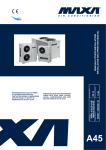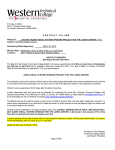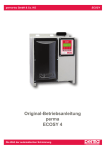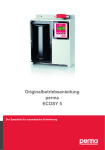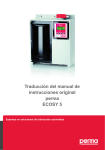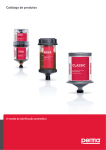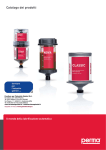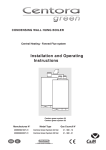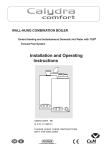Download Saunier Duval Ecosy 2 SB 28E Operating instructions
Transcript
Heating and hot water for the professionals ECOSY ECOSY 24 E, ECOSY 5B 24 E is CAT II2H3+ appliances IN WARRANTY TECHNICAL HELPLINE 01773 828400 ECOSY 28 E, ECOSY 5B 28 E is CAT I2H appliances 01773 828100 1 INSTALLATION AND OPERATING INSTRUCTIONS ECOSY 24 E, ECOSY SB 24 E ECOSY 28 E, ECOSY SB 28 E Note! The boiler serial number is marked on the label attached to the top of the inner bulkhead. Refer to the 'Introduction' section page 3 for a description of the basic functions of the boiler. The 'Users' section describes how to safely operate the boiler. USERS SECTION Introduction .................................................. Page 3 Commissioning ....................................................... 3 Controls & lighting ............................................ 4 - 6 Draining ................................................................... 7 Servicing/maintenance ........................................ 7 INSTALLATION SECTION Introduction ................................................. Page 3 Technical data ...................................................... 8 Dimensions ............................................................. 9 Boiler schematic ................................................... 9 Connections plate .............................................. 10 Piping system installation ................................... 10 Heating system design ....................................... 11 Domestic hot water system design .................. 12 Boiler location ..................................................... 12 Boiler installation ................................................. 13 Flue installation ............................................. 14 - 15 Electrical installation ........................................... 16 Commissioning .................................................... 17 Operating safety devices .................................. 18 Settings ................................................................. 19 Changing gas type ............................................ 20 Mandatory warning for CEE countries Warning: This appliance is designed, approved and inspected to meet the requirements of the English market. The identification plate located on the inside of the appliance certifies the origin where the product was manufactured and the country for which it is intended. If you see any exception to this rule, please contact your nearest Saunier Duval dealer. Thank you in advance for your assistance. 2 INTRODUCTION The ECOSY 24 E and ECOSY 28 E boilers are wall mounted combination boilers providing central heating and instantaneous hot water. The ECOSY SB 24 E and ECOSY SB 28 E boilers are wall mounted system boiler providing central heating only. The ECOSY 24 E and ECOSY SB 24 E boilers are of the II2H3+ category for use with Natural Gas (G20) and Liquide gas (G30 and G31)as distributed in the United Kingdom. The ECOSY 28 E and ECOSY SB 28 E boilers are of the I2H category for use with Natural Gas (G20) as distributed in the United Kingdom. The boilers have a fan assisted balanced flue which both discharges the products of combustion to and draws the combustion air from the outside of the room. The boilers are suitable for top outlet flue connection only but, can be fitted with horizontal flue, vertical flue or twin-pipe flue. Refer to flue catalogue for further details. On ECOSY 24 E and ECOSY 28 E, both the central heating and domestic hot water temperature are user adjustable from the boiler control panel. On the ECOSY 24 E and ECOSY 28 E, domestic hot water demand always has priority over heating demand. The boiler is designed for use as part of a sealed water central heating system with fully pumped circulation. The pump, expansion vessel and associated safety devices are all fitted within the boiler. The boiler can be installed against either an external wall or on an adjacent inside wall, that is, the flue system will pass directly to the rear or to either side to the terminal fitted on the outside wall face. The installation must be carried out by a competent person in accordance with the relevant requirements of The Building Regulations, The Water Byelaws, The Building Standards (Scotland) Regulations and any applicable local regulations. These instructions should be carefully followed for the safe and economical use of your boiler. Ancillary equipment A range of flue accessories are available including vertical flues, twin-pipe flues, bends etc. For further information contact your supplier. On ECOSY SB 24 E and ECOSY SB 28 E, the central heating temperature is user adjustable from the boiler control panel. COMMISSIONING Gas safety (Installation and use) Regulations In your interests and that of gas safety, it is the law that ALL gas appliances are installed and serviced by a competent person in accordance with the above regulations. Diagram. 1 OPENING THE CONTROL PANEL COVER Ins 048a Gas leak or fault If a gas leak or fault exists or is suspected, turn the boiler off and consult the local gas supply company or your installation/service company. Boiler controls The control panel, located at the lower front of the boiler casing, see diagram 1, allows the boiler to be started, shut down, controlled and monitored during use. Flue Do not obstruct the outside terminal of the boiler. Starting the boiler Before starting the boiler check that: - The gas meter tap is open. - The boiler gas service cock is open. - The boiler is connected to the electrical supply and turned on. 3 CONTROLS AND LIGHTING The control panel, located at the lower front of the boiler casing, see diagram 2, allows the boiler to be started, shut down, controlled and monitored during use. Control panel description (diagram 2): 1 - ON/OFF switch 2 - Summer/winter switch 3 - PC connector 4 - Reset button 5 - Display 6, 7, 8 and 9 - Program selection buttons 10 - Pressure gauge Diagram 2 1 2 3 4 5 6 7 8 9 10 2 bAR 1 65 IMIT PC SET ENTER Stopping the boiler Make sure that: ● The boiler is connected to the electrical supply. ● The boiler gas service cock is open. ● The pressure gauge reads between 1 and 2 bar. ➜ MODE ➜ PUSH IN BUTTON 2 IN SUMMER POSITION TO STOP THE BOILER ➜ Starting the boiler PUSH IN BUTTON 1 TO START BOILER ON ➜ ON OFF ➜ PUSH BUTTON 2 TO POSITION TO SET THE BOILER TO SUMMER MODE OFF To ensure maximum life of the boiler control system, it is recommended that the mains is left switched on all the time. Power consumption during stand by is only 7 to 8 watts. SETTING TO WINTER MODE (heating and hot water) SETTING TO SUMMER MODE (Hot water only) ➜ PUSH BUTTON 2 TO BOILER TO WINTER MODE POSITION TO SET THE ➜ ➜ ON OFF To obtain domestic hot water, open a hot water tap. 4 3 4 Hab 197a 0 O ON OFF Assuming that any remote heating controls are calling for heat, the above procedure is all that is required to start the boiler in heating mode. Hot water has priority over heating. CONTROLS AND LIGHTING Setting domestic hot water temperature 1 - Press «Mode» button once ➭ 1. 65 set ➭ 2. 65 ➜ mode 2 - Press «+» or «-» button to set the desired hot water temperature from 40°C to 65°C (factory set at 65°C) 2. 6 0 ➭ - + ➭ 2. 60 set ➭ 1. 65 twice Hab 198a enter ➜ 3 - Press «enter» until the display starts flashing, and press «mode» twice : the boiler is now operational at the desired hot water temperature. Note : On the SB versions, this setting is done using the tank thermostat in the tank. Setting heating temperature 1 - Press «Mode» button once ➭ 1. - 2 - Press «Set» button 4 times to show 5 on the left 60 mode 3 - Press «+» or «-» button to set the desired heating temperature from 20°C to 90°C (factory set at 70°C) mode ➭ 1. 65 set ➭ 6. 70 4 - Press «enter» until the display starts flashing, and press «mode» twice : the boiler is now operational at the desired heating temperature. twice - ➭ 6. 8 5 Hab 198a + Note : 1/ In case of under floor heating systems, the CH flow temperature can be set to between 20 ° C and 45°C - contact the Saunier Duval Technical Helpline 01773 828400. In all cases, by pressing the «Mode» button until the decimal point disappears, the display reverts to normal position : 0 65 No decimal point displayed 5 BOILER OPERATING MODES AND DISPLAY READINGS The Ecosy display has three display modes : A - Reading mode only - this gives information about the operation in progress. B - Programming mode - this allows the user to change selected settings of the boiler. C - Diagnostic mode - this allows the user to check selected temperatures during boiler operation. A- Reading mode only 70 Flashing decimal point displayed No decimal point displayed Allows the user to check selected temperatures during boiler operation. During boiler operation, the display gives information about the operation in progress (left hand digit) and the temperature of that operation (right hand digits). 1 - Press «Mode» button twice : The number 1 will be displayed with a flashing decimal point after it. Flow temperature ➭ 1. mode ➜ 1 - Safety purge ➜ B - Programming mode 65 65 65 65 65 65 65 65 65 65 ➭ 1. 2 - Press «Set» button to select the setting that you wish to check (see table below). ➭ 3. set Hab 206 0 1 2 - Ignition ➜ 2 3 - Boiler on - central heating ➜ 3 4 - Boiler on - hot water ➜ 4 5 - Waiting for closing air pressure switch ➜ 5 6 - Boiler off after reaching temp. ➜ 6 7 - Pump overrun after heating ➜ 7 8 - Pump overrun after hot water ➜ 8 9 - Boiler safety shut down ➜ 9 0 - No demand 70 50 Reg 025 0 65 ➭ 1. C - Diagnostic mode : 1 - Central heating flow temperature 2 - Central heating return temperature 3 - Cylinder temperature 4 - Not applicable 5 - Not applicable 6 - Not applicable 7 - Calculated temperature set 8 - Temperature rise of central heating flow 9 - Temperature rise of cylinder 7 0 Decimal point displayed Five settings of the boiler can be changed by the user. 1 - Press «Mode» button once : The number 1 will be displayed with a decimal point after ➭ mode it. 1. 7 0 set Programme ➭ 3. 00 ➭ 3. 0 1 4 - Press «Enter» button and then press «Mode» button twice to exit from the programming mode into the display mode. enter ➭ 2. 60 ➜ 2 - Press «Set» button to select the setting that you wish to change (see table below). 3 - Press «+» or «-» button to adjust the settings according to the table below set ➭ 1. 65 Setting 1 ➜ Domestic hot water temperature ............................... adjustable from 40°C to 65°C (factory set at 65°C) 2 ➜ Domestic hot water comfort level ............................... factory set at 02 - do not adjust 3 ➜ Pump operation ............................................................. 00 = do not use ......................................................................................... 01 = Intermittent pump (factory setting) ......................................................................................... 02 = continuous pump 4 ➜ Heating economy .......................................................... factory set at 02 - do not adjust 5 ➜ Heating flow temperature ............................................ adjustable from 20°C to 90°C (factory set at 70°C) 6 DRAINING Protection against freezing If the boiler is to be out of use for any long periods during severe weather conditions, it is recommended that the whole system, including the boiler, be drained to avoid the risk of freezing. If in doubt, consult your servicing company. The ECOSY boilers have a built in frost protection device that protects the boiler from freezing. If the boiler is to be left and there is a risk of frost, ensure that the gas and electrical supplies are left connected and that the ON/OFF switch is left in the ON position.The frost protection device will switch the pump when the temperature of the boiler water falls below 7°C and light the boiler when the temperature falls below 3°C. When the temperature reaches 10°C, the boiler stops. The pump will run again 15 minutes. Note: This device works irrespective of any room thermostat setting and only protects the boiler. Always ensure that adequate frost protection is given to the entire system where necessary. Draining and filling Caution: The boiler is installed as part of a sealed system which must only be drained and filled by a competent person. Heating safety valve CAUTION: A safety valve with a discharge pipe is fitted to these boilers. The valve MUST NOT BE TOUCHED except by a competent person. If the valve discharges at any time, switch the boiler off and isolate it from the electrical supply. Contact your installation/service company. SERVICING/MAINTENANCE To ensure the continued efficient and safe operation of the boiler, it is recommended that it is checked and serviced at regular intervals. The frequency of servicing will depend upon the installation conditions and usage but, in general, once a year should be enough. Cleaning The boiler casing can be cleaned with a damp cloth followed by a dry cloth to polish. Do not use abrasive or solvent cleaners. Boiler casing CAUTION. Do not remove or adjust the casing in any way, as incorrect fitting may result in faulty operation. If in 7 Heating output Efficiency Part load efficiency 30% (50°C/30°C) Maximum heating temperature Expansion vessel effective capacity Expansion vessel charge pressure Maximum system capacity at 75°C Safety valve, maximum service pressure Products outlet Fresh air inlet Hot water output Maximum hot water temperature automatically adjustable from (kW) to (kW) from (Btu/H) to (Btu/H) (%) (%) (°C) (l) (bar) (l) (bar) (mm) (mm) ECOSY SB 28 E ECOSY 28 E ECOSY SB 24 E ECOSY 24 E TECHNICAL DATA 6,8 6,8 24,5 24,5 23217 23217 83649 83649 98,9 98,9 109,3 109,3 90 90 7 12 0,5 1 150 215 3 3 Ø 60 Ø 60 Ø 100 Ø 100 8,9 28,8 30386 98330 97,5 106,8 90 7 0,5 150 3 Ø 60 Ø 100 8,9 28,8 30386 98330 97,5 106,8 90 12 1 215 3 Ø 60 Ø 100 automatically variable from (kW) to (kW) from (Btu/H) to (Btu/H) (°C) 6,8 24 23,21 81,89 65 — — — — — 8,9 28,8 30386 98330 65 — — — — — l/min (bar) 11,4 8 — — 13,3 8 — — (V) (W) 230 115 230 115 230 132 230 132 Specific flow rate (for 30°C temperature rise) Maximum supply pressure Electrical supply Maximum absorbed power Natural gas (G20) Ø Burner injector (mm) 4,9 4,9 5,6 5,6 Supply pressure (mbar) 20 20 20 20 Gas rate (maximum) (m3/h) 2,6 2,6 3,0 3,0 Gas rate (minimum) (m3/h) 0,7 0,7 0,9 0,9 (mm) Liquide gas (G30/G31) Ø Burner injector 4,15 4,15 / / Supply pressure (mbar) 28 30/37 / / Gas rate (maximum) (m3/h) 0,86 0,86 / / Gas rate (minimum) (m3/h) 0,36 0,36 / / Pump : Note : Curves 1,2 and 3 correspond to each of the three pump speed settings. ECOSY 24 E, ECOSY SB 24 E ECOSY 28 E, ECOSY SB 28 E 30 2 20 10 0 1 500 1000 1500 60 50 40 30 20 10 0 flow rate through heating system (l/h) Diagram 3 8 2 Pom 048 40 Available pressure between heating flow and return 3 Pom 043 c Available pressure between heating flow and return 70 50 (10 kPa = 1 mWG) 500 1000 1500 2000 flow rate through heating system (l/h) DIMENSIONS Diagram 4 201,5 227 890 (Ecosy 24 E/SB 24 E) 890 985 (Ecosy 28 E/SB 28 E) The boiler is delivered in three separate packages : - the boiler itself - the fixing jig - the flue system ECOSY 24 E Net weight : 68 kg Gross weight : 72 kg ECOSY SB 24 E Net weight : 58 kg Gross weight : 62 kg Hab 204a ECOSY SB 28 E Net weight : 63 kg Gross weight : 77 kg 140 ECOSY 28 E Net weight : 73 kg Gross weight : 87 kg 520 373 BOILER SCHEMATIC Diagram 5 2 ➞ 1 17 3 4 5 16 15 6 8 18 7 19 9 14 10 13 11 12 Hab 205 - ➞ Automatic air vent Air inlet/ flue products outlet Heat exchanger Central heating flow thermistor Burner Viewing window with ignition electrode Air pressure switch Fan Electronic control box Gas valve Condense drain Pressure gauge Pump 3-way valve (ECOSY 24 E/28 E only) Expansion vessel Cylinder (ECOSY 24 E/28 E only) Cylinder automatic air vent (ECOSY 24 E/28 E on&ly) 18 - Central heating return thermistor 19 - Domestic hot water thermistor (ECOSY 24 E/28 E only) 1 2 3 4 5 6 7 8 9 10 11 12 13 14 15 16 17 9 CONNECTION PLATE ECOSY SB 24 E, ECOSY SB 28 E From left to right, the connection plate is equipped with: A - Heating return with isolating valve (m). C - Heating flow with isolating valve (q), drain screw (r) and safety valve (s). E - Electrical connector. F - Gas service cock. ECOSY 24 E, ECOSY 28 E From left to right, the connection plate is equipped with: A - Heating return with isolating valve (m). B - Cold water inlet with isolating valve (p). C - Heating flow with isolating valve (q), drain screw (r) and safety valve (s). D - Domestic hot water outlet. E - Electrical connector. F - Gas service cock. 0 1 1 23 3 11 2 m 1 p 5 5 s 25 ,5 7 5 m p 3 A r 4 B Diagram 7 E q C Filters and washers : 1 - Fibre washer 2 - Metal filter 3 - Plastic filter 4, 5 & 6 - Black graphite s 5 6 D Diagram 6 7 F Pla 144a 33 2 C ,5 7 5 34 1 q 5 5 3 11 5 Pla 202 r A 23 5 1 1 25 F E PIPING SYSTEM INSTALLATION Heating system connections - Pipe diam 22 mm Hot water system connections (ECOSY 24 E/ 28 E only) - Pipe diam 15 mm ● Gas connection - Pipe diam 22 mm ● Safety valve discharge - Pipe diam 22 mm ● Water connection Connect the copper tails and isolating cocks supplied, to the boiler, see diagram 6 or 7. Connect the system pipework to the boiler observing the correct flow and return format as shown in diagram 6 or 7. boiler, the discharge must be extended using not less than 15 m o.d. pipe, to discharge in a visible position outside the building, facing downward preferably over a drain. The pipe must have a continuous fall and be routed to a position so that any discharge of water, possibly boiling or steam, cannot create any danger to persons, damage to property or external electrical components and wiring. Tighten all pipe connection joints. Gas connection The supply from the governed gas meter must be of adequate size to provide a constant inlet working pressure of 20 mbar (8 in w.g.). To avoid low gas pressure problems, it is recommended that the gas supply is connected using 22 mm pipe. ● On completion, the gas installation must be tested using the pressure drop method and purged in accordance with the current issue of BS6891. ● Safety valve discharge WARNING. It must not discharge above an entrance or window or any type of public access area. Connect the safety valve discharge pipe to the boiler, the discharge must be extended using not less than 15 m o.d. pipe, to discharge in a visible position outside the building, facing downward preferably over a drain. The pipe must have a continuous fall and be routed to a position so that any discharge of water, possibly boiling or steam, cannot create any danger to persons, damage to property or external electrical components and wiring. Tighten all pipe connection joints. Connect the safety valve discharge pipe to the 10 Gas Safety (Installation and use) Regulations In your interests and that of gas safety, it is the law that ALL gas appliances are installed and serviced by a competent person in accordance with the above regulations. HEATING SYSTEM DESIGN Ecosy SB 24 E/SB 28 E : 1 bar (corresponding to a static head of 10 m w.g.) and allows a maximum system volume of 215 l, for an average temperature of 75°C and a maximum service pressure of 3 bar. This pressure setting can be modified at commissioning stage if the static head differs. An additional expansion vessel can be fitted to the system if required, see diagram 8. The ECOSY boilers are compatible with any type of installation. ● ● Heating surfaces may consist of radiators, convectors or fan assisted convectors. ● Pipe sectional areas shall be determined in accordance with normal practices, using the output/ pressure curve (diagram 3). The distribution system shall be calculated in accordance with the output requirements of the actual system, not the maximum output of the boiler. However, provision shall be made to ensure sufficient flow so that the temperature difference between the flow and return pipes be less than or equal to 20°C. The minimum flow is 400 l/h. ● Provision shall be made for a drain valve at the lowest point of the system. ● Where thermostatic radiator valves are fitted, not all radiators must be fitted with this type of valve, and in particular, where the room thermostat is installed. In the case of an existing installation, it is ESSENTIAL that the system is thoroughly flushed prior to installing the new boiler using a propietary cleanser such as Sentinel X 400. In addition, it is recommended that an inhibitor Sentinel X 100, is added to the system in accordance with the recommendations of Betz-Dearbourn Ltd., Foundry Lane Widnes, Cheshire WA8 8UD. ● The piping system shall be routed so as to avoid any air pockets and facilitate permanent venting of the installation. Bleed fittings shall be provided at every high point of the system and on all radiators. ● ● The total volume of water permitted for the heating system depends, amongst other things, on the static head in the cold condition. The expansion vessel on the boiler is pressurised at : Ecosy 24 E/28 E : 0,5 bar (corresponding to a static head of 5 m w.g.) and allows a maximum system volume of 150 l. Filling the system Provision must be made for filling the system at low level. The use of a WRC approved filling loop is strongly recommended, connected as shown in diagram 8. Diagram 8 Return Cold supply Domestic water Boiler Hot Additional expansion vessel (if required) Bypass valve Filling device Flow control valve Drain point Sch 173a Heating circuit 11 DOMESTIC HOT WATER SYSTEM DESIGN ECOSY 24 E/ 28 E only ● Copper tubing must be used for the domestic hot water system. Unnecessary pressure losses should be avoided. ● A flow restrictor is factory fitted in the cold water inlet before the thermostatic valve. This limits the flow through the boiler to a maximum of 12 l/min. Hard water areas The temperatures within the heat exanger are limited by the boiler control system to minimise scale formation within the hot water pipework. However, areas where the water is "hard" (i.e. more than 200 mg/litre), it is recommended that the domestic hot water temperature is reduced to 55°C or below. Refer to the Controls and lighting section to reset the domestic hot water temperature. It is also recommended that a scale reducer is fitted. Refer to the manufacturers instructions or consult the local water company for additional advice. BOILER LOCATION 103 33 20 3% 1,5 ØA ØB ØA ØA ØA ØA ØB ØB 1,5 20 40 mini 40 mini Diagram 9 Ins 033AT 65 Clearances The position of the boiler must be such that there is adequate space for servicing. The recommended clearances are: 40 mm either side of the boiler. 600 mm at the front of the boiler. 300 mm below the boiler. Fixing jig The fixing jig comprises three parts: 1) The connecting plate which allows the connection and soundness testing of all the pipework before the boiler is fitted and helps support the weight of the boiler. 2) The hook which supports the weight of the boiler. 3) The template which ensures the hook and connecting plate are correctly fitted relative to one another. ● Place template on wall in required position, making allowances for the necessary clearances etc. Note: It is permissible to install the boiler with reduced clearances at the bottom and sides of the boiler PROVIDING that adequate consideration is given for Servicing/Repairs at a later date. If any doubt exists, contact the Saunier Duval Technical Helpline 01773 828400. ● Mark the position of the holes for the hook and connecting plate. ● Drill, plug and fix the connecting plate and hook to the wall using suitable screws. ● Check that both the hook and connecting plate are level. If the boiler is not installed immediately, protect the various couplings to prevent any ingress of foreign materials e.g. plaster, paint etc. 42 Terminal position The minimum acceptable spacings from the terminal to obstructions and ventilation openings are shown in diagram 10. The boiler must be installed so that the terminal is exposed to the external air. Should any doubt exist as to the permissible position of the terminal, contact the Saunier Duval Technical Helpline 01773 828400. Cupboard or compartment ventilation The boiler can be fitted in a cupboard or compartment as long as adequate permanent high and low level ventilation is provided in accordance with ventilation requirements Diagram 10 Minimum dimensions (in mm) for the positioning of flue terminals 12 - under a window ............................................ 300 under an air vent .......................................... 300 under a gutter ................................................. 75 under a balcony ........................................... 300 from an adjacent window ........................... 300 from an adjacent air vent ........................... 300 from vertical or horizontal air pipes ............... 300 from an external corner of the building ..... 300 from an internal corner of the building ...... 300 from the ground or from another floor ........... 300 between two terminals vertically .............. 300 between two terminals horizontally ........... 600 G N C E F M A B D I H L Ven 060b A B C D E F G H I L M N BOILER INSTALLATION Statutory requirements The installation of this boiler must be carried out by a competent person in accordance with the relevant requirements of the current issue of: Connect the various couplings between boiler and connection plate. ● Fit water trap supplied (diagram 11) to the condense outlet located underneath and to the left rear of the boiler. The outlet of the trap must then be connected to the household drainage system via a suitable water trap, such as a washing machine type trap. ● The Gas Safety (Installation and Use) Regulations The Building Regulations The local water company Byelaws The Building Standards Regulations (Scotland) The Health and Safety at Work Act BEFORE STARTING THE BOILER, THE TRAP MUST BE FILLED WITH WATER. Sheet metal parts WARNING. When installing or servicing this boiler, care should be taken when handling the edges of sheet metal parts to avoid the possibility of personal injury. Diagram 11 Installing the boiler Prior to starting work, the system must be thoroughly flushed so as to eliminate any foreign bodies and contaminants such as filings, solder particles, oil, grease etc. Hose to be connected to a drain Ins 030 120 20 1, 5 Note. Solvent products could cause damage to the system. ● Engage boiler upper part onto the hanging bracket. ● Allow the boiler to seat down onto support plate. ● Fit filter and washers, strictly adhering to the sequential order and directions shown on diag. 6 (Ecosy 24 E/28 E) or diag. 7 (Ecosy SB 24 E/SB 28 E). 20 1, 5 227 227 12 Ø Ø 80 0 Hab 212a 80 Diagram 12 13 FLUE INSTALLATION 20 B - Flue to side of boiler ● Mark the horizontal centre line for the hole on the rear wall. Extend the horizontal centre line to the side wall and mark the vertical centre line of flue hole as shown in diagram 13. 33 103 The boiler is only suitable for top outlet flue connection. A - Flue to rear of boiler ● Mark correct position of hole from template. 3% 1,5 ØA ØB ØA ØA ØA ØA ØB ØB 1,5 20 40 mini 40 mini Ins 033AT Important : When cutting the flue hole and when extending the flue centre line to a side wall, remember that the flue system must have a fall of about 35 mm per metre of flue DOWNWARD TOWARDS the boiler. There must NEVER be a downward incline towards the terminal. 65 Under normal circumstances, it will be possible to gain access to the outside of the building to fit the flue terminal assembly. Where outside access is not possible e.g. high rise buildings, the flue terminal can be fitted from inside the building only if required. 42 Diagram 13 Cutting the flue hole ● Making allowance for the slope of the flue, cut hole in external wall, preferably using a core drill. For installations with internal and external access Use a 105 mm diameter core drill. For installations with internal access only - Use a 125 mm diameter core drill. Important : Before cutting the hole for flues to the rear of boiler, always cover fixing jig to make sure it is not damaged. e a X X Diagram 14 Table 1 Flue option Rear flue Cutting length (mm) outer pipe inner pipe e + 196 e + 271 maximum wall thickness "e" without extension 554 mm maximum distance "X" without extension 755 mm Side flue right e + a + 288 e + a + 363 maximum distance "X" without extension 755 mm Outer pipe Cutting length Table 2 Inner pipe Cutting length Ven 089a Terminal end Comments Side flue left e + a + 222 e + a + 297 Diagram 15 14 e a Hab 210b Calculation of flue cutting lengths ● Measure wall thickness e (mm), see diagram 14. ● For side flues, measure distance from inside face of side wall to centre line of flue and subtract 293 mm for right hand flue or subtract 227 mm for left hand flue to get dimension a (mm). ● Refer to table 1 for cutting lengths of both inner and outer flue pipes for each of the various flue options available. Important : All flue cutting lengths must be measured from the terminal end of the flue pipes, see diagram 15. When the dimension X measured on site is greater than that given in table 1, a flue extension kit will be required, refer to table 2 for details. Flue option Dimension "X" N° of extension kits Side flue left or right 756 to 1756 mm 1757 to 2757 mm 1 2 FLUE INSTALLATION Extended flue The horizontal flue is extended by using one or more of the 1000 mm extension pipes part number 85452. These are connected together by push fit type joints. Calculation of flue cutting lengths for extended flue ● Using the correct number of extension kits as table 2, measure dimensions a and e, see diagram 14. Cut both the inner and outer pipe to the dimension given in table 3. Table 3 Flue option Cutting length (mm) outer pipe inner pipe Comments Side flue left e + a - 493 e + a - 483 maximum dimension "X" without extension 755 mm Side flue right e + a - 427 e + a - 417 maximum dimension "X" without extension 755 mm Important : All cutting lengths should be measured from the push fit joint end of the extension pipe. Do not leave any burrs or sharp edges on the cut end of the pipes. Diagram. 16 Installation of flue assembly (see diagram 16) ● Fit rubber sealing collar (A) into groove at the outer end of pipe (B). ● For internal access only installation, that is with 125 mm diameter hole, fit rubber spacer (D) to outer flue to support flue in wall. Fit outer pipe (B) into wall with line marked on flue uppermost and groove to the outside. ● E A B D C F G Ven 094b Pull pipe inwards to bring rubber sealing collar hard up against external wall. ● ● For both internal and external access installation, fit the rubber sealing flange (C) against the inside wall. ● From inside, insert inner pipe (E) into outer pipe, ensuring that groove on terminal end of pipe engages into tongue on outer pipe end cap. ● Engage boiler upper part onto hanging bracket, ● Allow boiler to seat down onto support plate, Diagram. 17 Fit filters and washers, strictly adhering to the sequential order and directions shown on diagram 6 or 7. Connect the various couplings between boiler and connection plate. ● ● From inside boiler, remove wire clip on flue adapter pipe. Push adapter pipe down into flue outlet pipe, see diagram 17. ● Fit rubber air inlet dome (F) to elbow, engaging it on the outer part. ● Push flue adapter pipe up and engage it onto inner part of elbow. Refit wire clip Ins 047 ● Fit elbow ( G) onto inner and outer flue ensuring inner flue is correctly engaged into elbow. Note : To allow easier engagement of elbow onto flue, use a small quantity of silicone grease. ● Secure rubber air inlet dome (F) to top of boiler with plate and screws. 15 ELECTRICAL CONNECTION Warning. This boiler must be earthed All system components must be of an approved type. Connection of the whole electrical system and any heating system controls to the electrical supply must be through a common isolator. Isolation should preferably be by a double pole switched fused spur box having a minimum contact separation of 3 mm on each pole. The fused spur box should be readily accessible and preferably adjacent to the boiler. It should be identified as to its use. A fused three pin plug and shuttered socket outlet may be used instead of a fused spur box provided that: a) They are not used in a room containing a fixed bath or shower. b) Both the plug and socket comply with the current issue of BS1363. The mains electrical supply must be maintained at all times in order to provide domestic hot water. Do not interrupt mains supply with time switch/programmer. WARNING: ON NO ACCOUNT MUST ANY EXTERNAL VOLTAGE BE APPLIED TO ANY OF THE TERMINALS ON THE HEATING CONTROLS CONNECTION PLUG. Warning: This appliance must be wired in accordance with these instructions. Any fault arising from incorrect wiring cannot be put right under the terms of the Saunier Duval guarantee. External controls The ECOSY condensing boilers are designed to operate at maximum efficiency at all times. The boiler will run at its’ maximum efficiency when connected to a programmable electronic room thermostat. A programmable room thermostat is available as an accessory, Saunier Duval part number 40010. Please contact your supplier. The boiler will work for heating without a room thermostat and/or timeswitch being connected provided that the wire link fitted between the upper two terminals of the connector is left in place, see diagram 18 a. A 230V room thermostat can be used but do not make any connection to the compensating resistor, see diagram 18a. ON NO ACCOUNT must any electrical voltage be applied to any of the terminals of the external controls plug. For use with a timeswitch or timeswitch and room thermostat, see diagram 18 a. ECOSY SB 24 E/SB 28 E The boiler will work for heating without a room thermostat and/or timeswitch being connected provided that the wire link fitted between the top two terminals of the connector is left in place, see diagram 18 b. A 230V room thermostat can be used but do not make any connection to the compensating resistor, see diagram 18b. ON NO ACCOUNT must any electrical voltage be applied to any of the terminals of the external controls plug. A voltage free storage cylinder thermostat, where fitted, should be connected to the lower two terminals of the external controls plug, see diag. 18 b. ON NO ACCOUNT must any electrical voltage be applied to any of the terminals of this plug. Warning: - All external controls must be voltage free - On no account must any external voltage be applied to any of the external controls plug terminals Diagram 18a Diagram 18b ECOSY 24 E, ECOSY 28 E ECOSY SB 24 E, ECOSY SB 28 E No external controls No external controls Factory fitted link Factory fitted link Boiler connector Voltage free room thermostat Room thermostat only External controls plug External controls plug Do not connect Do not connect Timeclock, room thermostat and cylinder thermostat Time clock External controls plug 16 Voltage free room thermostat Do not connect External controls plug Time clock Voltage free room thermostat Voltage free cylinder thermostat Sch 070UK Room thermostat and time clock Do not connect Room thermostat only Voltage free room thermostat COMMISSIONING The commissioning and first firing of the boiler must only be done by a competent person. Gas installation It is recommended that any air is purged from the supply at the gas inlet test point on the lower right hand side of the gas valve, see diagram 19. Filling the system ● Open shut off valves (see diag. 6 or 7 as appropriate) (slot of screw corresponds to flow direction), and caps on automatic air vents on top RHS of boiler. ● Bleed each radiator until a continuous jet of water is obtained. ● Do not close automatic air vent caps on top of boiler. ● Open various hot water taps to bleed system. ● Make sure that pressure gauge reads between 1 and 2 bar. Re-pressurise system as necessary. Important: - When venting air from boiler, do not touch the schrader valve on the expansion vessel, it is NOT a vent. - When the mains supply is connected to the boiler, or after a reset, the three way valve (Ecosy 24 E and Ecosy 28 E only) is activated for approx. 15 seconds and switched to the heating circuit. The pump will run for 1 minute. After this period, the three way valve returns to the cylinder circuit. - If, during a 24 hour period, there has been no heating demand, the above procedure is automatically repeated. This is quite normal and is a function of the electronic control to prevent the possibility of the valve and pump sticking. Starting the boiler Before starting the boiler check that: - The gas meter tap is open. - The boiler gas service cock is open. - The boiler is connected to the electrical supply. perature is reached. Shut down boiler and vent heating system. If necessary, top up heating system and make sure that a pressure of 1 bar is indicated on the pressure gauge when system is COLD. Gas pressures The Ecosy boilers are fully automatic in operation, adjusting the gas rate to the optimum for the type of system and conditions. It is not possible to manually adjust the burner pressure but it is necessary to ensure that there is a constant inlet working pressure of 20 mbar measured at gas valve. Proceed as follows: ● Shut down boiler. ● Undo screw on gas inlet test point on lower right hand side of gas valve, see diagram 19. ● Connect a suitable pressure gauge. ● Start boiler as described in 'Instructions for Use'. To check the inlet working pressure, the boiler has to be held at full gas rate. Proceed as follows: ● Press the 'Mode' and '+' buttons simultaneously - the letter H is displayed and the boiler is now running at full gas rate. ● Check that there is a pressure of 20 mbar (G20), 2830 mbar (G30), 37 mbar (G31). If the pressure is insufficient, it is necessary to check the gas supply/pipework and correct any fault. Note. The central heating operation of the boiler may seem to operate correctly with less inlet working pressure but the economy of the boiler will not be optimum. In any case, an insufficient inlet pressure will adversely affect hot water performance. ● Press the 'Reset' button. The boiler will revert to normal running, that is, will not be held at full gas rate. Note. 1) After a period of 20 minutes, the boiler will automatically revert to normal running. 2) During full gas rate operation, all safety devices can function fully. ● Shut down boiler. ● Remove pressure gauge, tighten up test point screw and check for gas soundness. Diagram 19 The temperature rise will cause release of the gases contained in the water of central heating system. - Gases driven towards the boiler will be automatically released through the automatic air vents. - The gases trapped at the highest point of the system must be released by bleeding the radiators. On reaching maximum temperature, the boiler should be turned off and the system drained as rapidly as possible whilst still hot. ● Refill system to a pressure of 1 bar and vent as before. ● Restart boiler and operate until a maximum tem- b Reg 026 First starting up ● Following the instructions given in the 'Controls and Lighting' section, set boiler to run in central heating mode. ● Set room thermostat for maximum temperature and check that external controls, if fitted, are calling for heat. ● Allow the temperature to rise to the maximum value, with all radiator valves open. Note: The Ecosy boilers start at reduced output for 10 minutes before running at full output. This is a function of the adaptive electronic boiler control and is quite normal. 17 OPERATING SAFETY DEVICES Gas leak or fault If a gas leak or fault exists or is suspected, turn the boiler off and consult the local gas undertaking or your installation/servicing company. attempt to relight. If the fault persists after 20 attempted relights, the boiler shuts down and requires a manual reset. Check pump speed and flow rate of the circulating system. In case of power supply failure The boiler no longer operates. As soon as power supply is restored, the boiler will be automatically restarted. 3) If the central heating flow temperature exceeds 100°C, the boiler shuts down and requires a manual reset. The right-hand digits of the display will show 18. - Check that the pump is operating, the central heating isolating cocks are open and that there is circulation in the system. 0 1 2 Important notice : A central heating system cannot operate satisfactorily unless it is properly filled with water and unless the air initially contained in the piping systems has been properly bled off. If these conditions are not satisfied, air noise will occur within the system. Air in the heating system Persistent air in the heating system may indicate leaks in the system or corrosion taking place. Call the nearest after sales service department. Overheating safety There are four overheat safety functions : 1) If the water temperature inside the boiler increases at greater than 4°C per second, the boiler will stop for 10 minutes. The display will show 9 alternaded with E 25. After this time, the boiler will attempt to relight. If the fault persists after 5 attempted relights, the boiler shuts down and requires a manual reset. The display will show 9 25 blinking. - Check that the pump is operating, the central heating isolating cocks are open and that there is circulation in the system. 2) If the temperature difference between the central heating flow and return pipes exceeds 40°C, the boiler will stop for 2,5 minutes. The display will show 9 alternaded with E 30. After this time, the boiler will 18 4) If the central heating return temperature exceeds 95°C, the boiler shuts down and requires a manual reset. The right-hand digits of the display will show 19. - Check that the pump is operating, the central heating isolating cocks are open and that there is circulation in the system. In case of boiler safety shut down, press the reset button Frost protection The Ecosy has a built in protection device that protects the boiler from freezing. If the boiler is to be left and there is a risk of frost, ensure that the gas and electrical supplies to the boiler are left connected. The frost protection device will light the boiler when the temperature of the boiler water falls below 3°C. When the temperature reaches 10°C, the boiler stops. Note : This device only protects the boiler. Always ensure that adequate frost protection is given to the system where necessary. Diagram 20 Hab 196 In case of loss of water in the system CAUTION :The boiler is installed as part of a sealed system which must only be drained and filled by a competent person. If the pressure shown on the pressure gauge (diagram 20) is less than 1 bar or if the number 12 is shown on the flashing display, the system must be filled up immediately. Call the nearest after sales service department. SETTINGS Alternatively, connect a CO2 analyser to the combustion test point on the flue elbow. ● Start the boiler. ● Press the «Mode» and «+» buttons simultaneously, the letter H is displayed and the boiler is now running at high gas flow rate. ● Allow the boiler to run for a few minutes to stabilise and check the CO2 value, refer to table 4. ● At the 28E and SB28E the CO2 at high gas flow rate is automatically controlled. ● At the 24E and SB24E the CO2 at high gas flow rate can be adjusted. To adjust the CO2, turn the gas valve adjuster until the correct CO2 value is obtained according to table 4. Press the «Mode» and «-» buttons simultaneously, the letter L is displayed and the boiler is now running at low gas flow rate. Allow the boiler to run for a few minutes to stabilise and check the CO2 value, refer to table 4. ● To adjust the CO2, remove protective cap (b) from the gas valve, see diagram 22. Turn the gas valve adjuster until the correct CO2 value is obtained according to table 4. Note :This adjustment must only be carried out by a suitably qualified engineer. Diagram 21 Ins 046 Gas valve setting All boilers are tested and factory set during manufacture. Should it be necessary to reset a gas valve, for example after replacement, proceed as follows : ● Shut down boiler. ● Connect a CO2 analyser to the combustion test point on the products outlet from the heat exchanger, see diagram 21. Diagram 22 ● Reg 026 b Diagram 23 Bypass The built-in bypass must be adjusted according to the requirements of the system. Refer to the flow rate pressure curve (diagram 3) The boiler is supplied with the built-in bypass open a half a turn. It is adjusted by turning the bypass screw (a), see diagram 23. Turn the screw clockwise to close the bypass. When using thermostatic radiator valves (TRV’s), a separate adjustable bypass of 15 mm minimum diameter must be fitted between the flow and return of the heating circuit. Any bypass must be fitted before system controls. Reg 033 a Table 4 ECOSY 24 E/ECOSY SB 24 E G20 ECOSY 28 E/ECOSY SB 28 E G30 G31 G20 Output 6,8 kW 24,5 kW 9,9-20,4 kW 11,4-24,5 kW 8,3 kW 28,0 kW Fan speed 1600 rpm 5300 rpm 2400-4800 rpm 2400-4800 rpm 1900 rpm 5700rpm 9,0 % 9,2 % 10,1-10,3 % 11,9-12,1 % 9,4 % 9,4 % casing fitted 9,2 % 9,4 % 10,4-10,6 % 12,3-12,5 % 9,6 % 9,6 % Start (%) 80 % 80 % 90 % 90 % 80 % 80 % CO2 with sealed casing removed CO2 with sealed 19 CHANGING GAS TYPE Conversion to a different type of gas only for ECOSY 24 E and ECOSY SB 24 E : Note : Conversion to a different type of gas is only possible with category II2H3+ appliances ! Conversion to a different type of gas must only be carried out by a specialist registered with the GVU or specialist authorised by Unical. Note : The appliances are normally supplied with the desired type of gas. Gas conversion units for other types of gas must be ordered separately. Detailed instructions for gas conversion are enclosed with these conversion units and must always be followed. A different gas jet is required for the conversion. Conversion units and their order numbers are shown in our current price list. Performing the conversion ● Remove the front cover of the appliance. ● Loosen the upper gas union and unscrew the gas jet ● Screw the new jet in tightly after checking it again for size ant tighten the union once more ● Check the union for tightness using leak detector spray ● After the details accordingly on the plate showing gas type. 20 104605 E 07/99




















